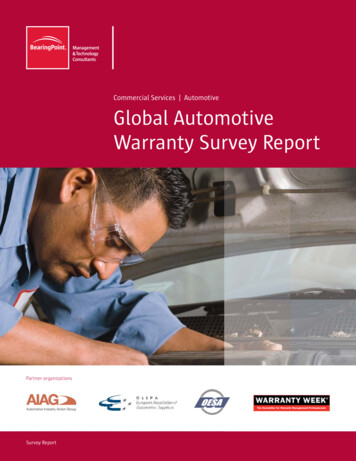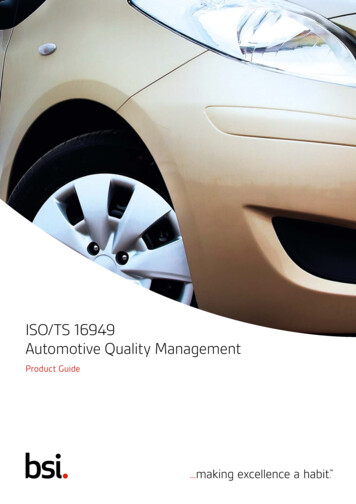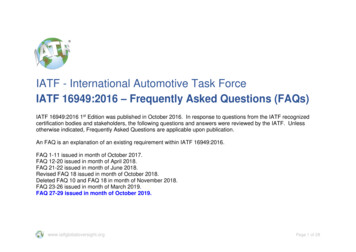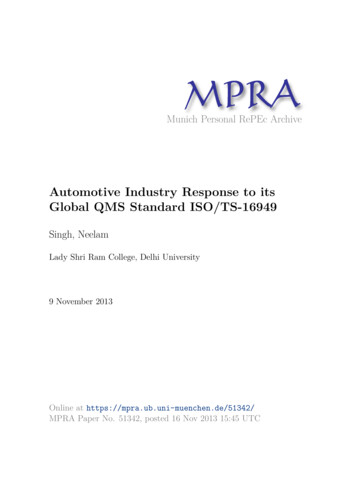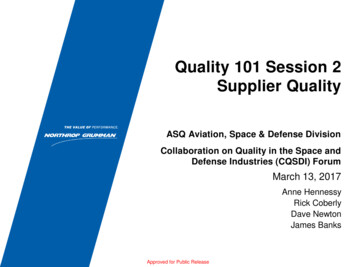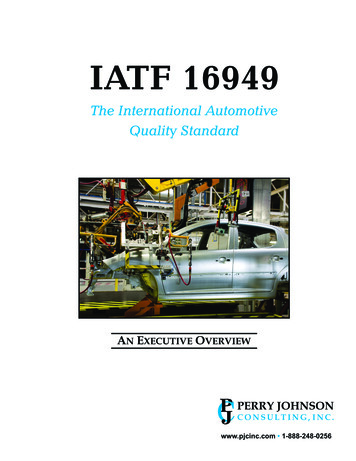
Transcription
IATF 16949The International AutomotiveQuality StandardAN EXECUTIVE OVERVIEWPERRY JOHNSONPCJ C O N S U L T I N G , I N C .www.pjcinc.com 1-888-248-0256
IATF 16949The International AutomotiveQuality StandardAN EXECUTIVE OVERVIEWRevised 12/16PERRY JOHNSON CONSULTING, INC.Detroit200 East Big Beaver Rd. Troy, Michigan 480831-888-248-0256 or (248) 519-2602PJC Home Page: www.pjcinc.com Email: pjc@pjcinc.com Copyright 2016 by PERRY JOHNSON CONSULTING, INC.All rights reserved. No part of this book may be reproduced in any formor by any means without permission, in writing, from Perry Johnson Consulting, Inc.
IATF 16949The International Automotive Quality StandardAn Executive OverviewCONTENTSForeword .2The Users of This Guide .3What is IATF 16949? .4What is ISO 9000? .5Annex SL – A Common Structure .5The Origin of ISO 9000 .5Deeper Origins - QS-9000, VDA 6.1, EAQF, AVSQ .7ISO/TS 16949 .8IATF 16949 – Certification Should Mean Something! .10Registering to IATF 16949 .11Key Steps to Completing Registration .12What to Look For in a Registrar .13What to Look For in an Auditor.14IATF 16949 Quality Management System Requirements .154 Context of the Organization .155 Leadership .176 Planning .197 Support .218 Operation.299 Performance Evaluation .4810 Improvement .53Customer-Specific Requirements .55Conclusion .57IATF 16949 Executive Overview - PJCPage 112/16
FOREWORDIATF 16949:2016 represents the next chapter in a storied history of certification for companies thatsupply to the automotive market. In the United States it began with the harmonization of the “Big 3”requirements into QS-9000. QS-9000 was an important step, but the industry wanted more. Drivenby the need for a harmonized quality management system standard for international automotivesuppliers, the International Automotive Task Force (IATF) in 1999 produced ISO/TS 16949, whichincluded requirements from various markets including Germany (VDA 6.1), France (EAQF) andItaly (AVSQ.) In 2002, ISO/TS 16949 was revised to align with ISO 9001:2000, and later revised in2009 to align with ISO 9001:2008.Now, as 2016 draws to a close the standard takes another ambitious stepforward as it has been rewritten to align with the new, Annex SL based,ISO 9001:2015 quality management system standard. This changealone adds a whole host of new and interesting requirements includingrisk based thinking, organizational knowledge, and the determination ofinterested parties.But this latest update doesn’t just represent a reshuffling of ISO/TS 16949:2009 into a newframework. The IATF put years of work into gathering feedback from numerous shareholders toensure that this new standard addresses all of the key concerns that have been expressed over themany years that ISO/TS 16949 was the standard of note. This included feedback from OEMs,Certification Bodies, Witness Auditors, and Oversight Offices. It also included a targeted effort toincorporate the various sanctioned interpretations and key FAQs that were accumulated over theyears.All of these changes center on one key directive from the automotive industry: prevent problemsbefore they occur!As before, any organization that seeks certification to IATF 16949 must meet not only therequirements found in the standard, but also the customer specific requirements raised by theircustomers (and in many cases their customer’s customers). ISO 9001:2015 is not included in theactual text of IATF 16949, but its requirements are referred to throughout the standard and areconsidered fully applicable.This guide was created to aid those suppliers who are about to embark upon the IATF 16949journey. It will help smooth out the bumps as it explains the general requirements of IATF 16949step-by-step. Since registering to this automotive standard is a lengthy and detailed process, it isstrongly suggested that firms seeking registration retain the services of a reputable consulting firm.PERRY JOHNSON CONSULTING, INC.Southfield, MichiganDecember 2016IATF 16949 Executive Overview - PJCPage 212/16
THE USERS OF THIS GUIDEThis guide will be useful to all suppliers who service the automotive industry and firms that meet anyof the following criteria: International automotive suppliers. Firms that supply production parts to automobile manufacturers. Companies that supply service parts to automobile manufacturers. Organizations that supply production materials to automobile manufacturers. Firms planning to improve their quality assurance and management programs. Companies that supply heat treating, painting, plating or other finishing services toautomobile manufacturers. Subcontractors that design products for automobile manufacturers and/or suppliers thatservice automobile manufacturers. Firms wishing to do future business with automobile manufacturers. Suppliers seeking a competitive advantage in the marketplace. Companies desiring to make customer satisfaction a top priority. Suppliers seeking to meet the customer IATF 16949 registration mandates. Any other firms interested in becoming registered to IATF 16949.IATF 16949 Executive Overview - PJCPage 312/16
WHAT IS IATF 16949?Automotive Quality Management System Standard IATF 16949:2016, Quality management systemsrequirements for automotive production and relevant service part organizations, is a qualitymanagement systems standard that was developed by the International Automotive Task Force(IATF).This standard is the end product of the most widespread standardization effort in the history of theautomotive industry. By standardizing their quality management systems, international automotivesuppliers no longer have to satisfy multiple national automotive quality standards, which were oftencontradictory and led to redundant audits. IATF 16949 removes that burden, making it easier forsuppliers to do business with automotive manufacturers around the world.This automotive standard applies to all internal and external suppliers of:1. Production or service parts;2. Production materials;3. Assemblies;4. Heat treating, welding, painting, plating or other finishingservices directly relating of automotive related parts.IATF 16949 continues a model that originated in the ISO/TS 16949 standard by merging automotivesector-specific requirements found in the United States, Italy, Germany, England, and France withISO 9001:2015, the core ISO 9000 quality management systems standard. However, unlike ISO/TS16949, the IATF 16949 standard does not include the requirements from ISO 9001:2015, but ratherreferences them. For this reason, any company that is seeking certification to IATF 16949 mustobtain copies of BOTH IATF 16949 and ISO 9001:2015 to ensure that they are aware of allapplicable requirements.Registration is the only objective way to assure your customers that you have a series of effectiveprocesses geared towards providing quality products. IATF 16949 registration is objective because aregistrar, an independent certifying body, performs regular audits to verify whether your qualitymanagement system is meeting all requirements. This independent evaluation is important to thecustomer because it is an unbiased assessment and is intended to inspire your organization toperform at its highest level.Because ISO 9001:2015 is the foundation of this standard, one must have a basic knowledge of ISO9001 in order to fully understand the fundamentals of IATF 16949. A brief description of this seriesof standards follows.IATF 16949 Executive Overview - PJCPage 412/16
What is ISO 9000?ISO 9000 is a series of quality management systems standards created by the InternationalOrganization for Standardization (ISO), a federation of national standards bodies based in Geneva,Switzerland. The American National Standards Institute (ANSI) is the member body representingthe United States. All standards are assigned a Technical Committee (TC.) TC 176 is the committeethat has responsibility for the ISO 9000 series of standards.The ISO 9000 quality management standards are not specific to products or services, but apply to theprocesses that create them. The standards are generic in nature so that they can be used bymanufacturing and service industries all over the world. First released in 1987 and revised in alimited manner in 1994, they underwent a major overhaul in 2000, and in 2008 interpretations wereadded to the ISO 9001:2000 standard.The latest version of ISO 9001 represented the culmination of several key goals for the ISO. Chiefamong these was the design to have a common structure for all ISO standards. To achieve this, theISO appointed a special Joint Technical Coordination Group (JTCG) in 2012 and tasked the JTCGwith development of a “core text” for the ISO family of standard. The results of their efforts wasgiven the name “Annex SL.”Annex SL – A Common StructureAnnex SL exists as part of a larger publication called “ISO Directives Part 1, Consolidated ISOSupplement – Procedures specific to ISO.” This expansive document can be thought of a“playbook” for the ISO to follow in the development of standards. It is projected that all ISOstandards will follow the Annex SL format by 2017. We will learn more about Annex SL and thestandardized format over the next several pages of this Executive Overview.The Origin of ISO 9000ISO 9000 is the descendant of a number of earlier quality standards, including the British BS 5750and DEF/STAN 05-8, the NATO AQAP-1 and the U.S. Department of Defense MIL-Q-9858A. Thepurpose for developing ISO 9000 was to simplify the international exchange of goods and servicesby creating a common set of quality standards.BS 5750 had the greatest influence on this international standard when it was first released by ISO in1987. Most industrialized nations quickly adopted harmonized versions of ISO 9000. Thesenational versions, which are identical to the international standard, include the AmericanANSI/ISO/ASQ Q9000, sponsored by ANSI and the American Society for Quality (ASQ), and theEuropean Union’s EN 29000.IATF 16949 Executive Overview - PJCPage 512/16
ISO 9001 is intended to provide requirements for an organization to establish, document andmaintain a quality management system for ensuring the consistency of a process. It is not mysteriousor esoteric, consisting instead of a group of common sense and generally well-known precepts laidout in an organized fashion.When implemented correctly, ISO 9001:2015 can offer your company several advantages. It willguide you to build consistency into your products or services, and can help you to avoid costlywarranty costs and rework.Today, the international standards are sanctioned by the European Union (EU), making ISO9001:2015 registration a virtual prerequisite for doing business in its member countries.Previously, there were more than 20 ISO 9000 standards and documents, and this proliferation raisedconcerns among ISO 9000 users and consumers. In response, the TC committee agreed that the 2000revision and all future revisions would consist of four primary standards, supported by severaltechnical reports. In addition to the ISO 9001:2015 standard, these three additional primarystandards are: ISO 9000:2015, Quality Management Systems – Fundamentals and Vocabulary. Thisdocument, which replaced the 2005 revision, provides all sanctioned interpretations for thenumerous terms used throughout the various standards. ISO 9000:2015 also provides anexamination of the Seven Quality Management Principles, including a statement of rationale.Finally, ISO 9000:2015 provides a number of helpful concept diagrams showing the intendedinterrelationships between ideas. ISO 9000:2015 is not a certifiable standa
It is projected that all ISO standards will follow the Annex SL format by 2017. We will learn more about Annex SL and the standardized format over the next several pages of this Executive Overview. The Origin of ISO 9000 ISO 9000 is the descendant of a number of earlier quality standards, including the British BS 5750 and DEF/STAN 05 -8, the NATO AQAP -1 and the U.S. D epartment of Defense MIL .

